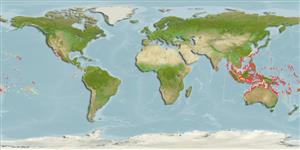>
Eupercaria/misc (Various families in series Eupercaria) >
Scaridae (Parrotfishes) > Scarinae
Etymology: Scarus: Greek, skaros = a fish described by anciente writers as a parrot fish; 1601 (Ref. 45335).
More on author: Valenciennes.
Environment: milieu / climate zone / depth range / distribution range
Écologie
marin récifal; profondeur 1 - 30 m (Ref. 86942). Tropical; 30°N - 32°S
Western Pacific: Thailand to New Caledonia, north to the Ryukyu Islands, south to Perth and New South Wales in Australia. Recently recorded from Tonga (Ref. 53797).
Taille / Poids / Âge
Maturity: Lm ? range ? - ? cm
Max length : 40.0 cm SL mâle / non sexé; (Ref. 2935); common length : 20.0 cm SL mâle / non sexé; (Ref. 2935)
Épines dorsales (Total) : 9; Rayons mous dorsaux (Total) : 10; Épines anales: 3; Rayons mous anaux: 9. This species is distinguished by the following features: 5-7 (usually 6) median predorsal scales; 3 scale rows on cheek 1(5-7), 2(5-7), 3(1-4); pectoral-fin rays 13-15 (usually 14); conical teeth on side of dental plate, none in female and usually 2 on upper and 0-1 on lower of dental plates for terminal male; lips nearly covering dental plates; caudal fin slightly rounded to truncate in female and emarginate in terminal male. Colour of patch covering cheek and gill cover of male orange, wavy band/lines on snout and cheek, pectoral fins pale green; female grey or grey-brown with 2 pale stripes on belly (Ref. 9793, 90102).
Found in silty coastal and offshore areas to 20 m deep (Ref. 90102). Inhabits rocky and coral reefs from tidal pools to at least 10 m deep. Form schools with 30 to 40 individuals. Grazes on benthic algae and corals (Ref. 2935). Reproductively active terminal males become bicolored (Ref. 37816).
Life cycle and mating behavior
Maturité | Reproduction | Frai | Œufs | Fécondité | Larves
Oviparous, distinct pairing during breeding (Ref. 205).
Randall, J.E. and J.H. Choat, 1980. Two new parrotfishes of the genus Scarus from the Central and South Pacific, with further examples of sexual dichromatism. Zool. J. Linn. Soc. 70:383-419. (Ref. 2689)
Statut dans la liste rouge de l'IUCN (Ref. 130435: Version 2024-2)
Menace pour l'homme
Harmless
Utilisations par l'homme
Pêcheries: commercial
Outils
Articles particuliers
Télécharger en XML
Sources Internet
Estimates based on models
Preferred temperature (Ref.
123201): 24.8 - 29.3, mean 28.5 °C (based on 2763 cells).
Phylogenetic diversity index (Ref.
82804): PD
50 = 0.5000 [Uniqueness, from 0.5 = low to 2.0 = high].
Bayesian length-weight: a=0.01514 (0.01004 - 0.02282), b=3.07 (2.95 - 3.19), in cm total length, based on LWR estimates for this species & Genus-body shape (Ref.
93245).
Niveau trophique (Ref.
69278): 2.0 ±0.0 se; based on diet studies.
Generation time: 5.0 ( na - na) years. Estimated as median ln(3)/K based on 1
growth studies.
Résilience (Ref.
120179): Milieu, temps minimum de doublement de population : 1,4 à 4,4 années (Preliminary K or Fecundity.).
Fishing Vulnerability (Ref.
59153): Moderate vulnerability (39 of 100).
Nutrients (Ref.
124155): Calcium = 33.4 [20.9, 54.9] mg/100g; Iron = 0.653 [0.439, 1.029] mg/100g; Protein = 18.4 [16.3, 20.2] %; Omega3 = 0.0847 [, ] g/100g; Selenium = 17.2 [10.0, 29.8] μg/100g; VitaminA = 67.9 [19.6, 226.2] μg/100g; Zinc = 2.36 [1.74, 3.13] mg/100g (wet weight);
